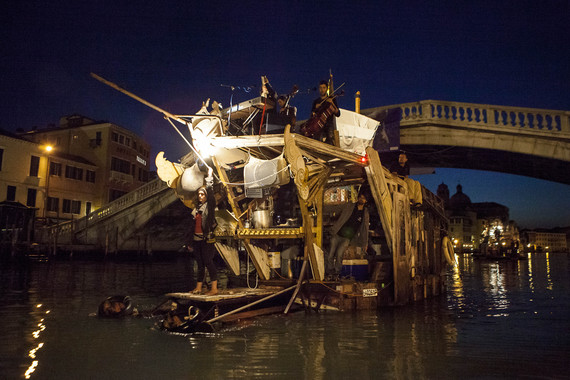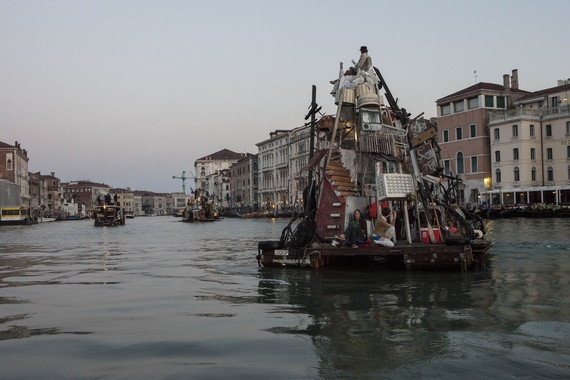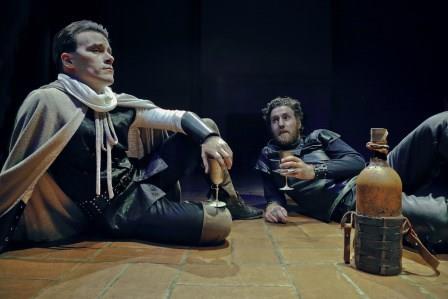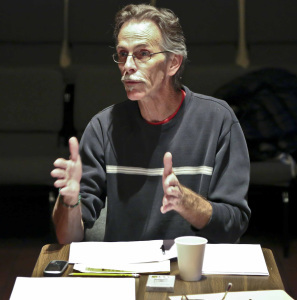Or not. Susan Stroman, the director/choreographer who worked with Mel Brooks on the aforementioned blockbuster, has now joined forces with Allen but lightning is not striking twice. The main culprit, it turns out, is those songs. Instead of enhancing and heightening the story, which is what ideally happens in a musical, the characters stop what they are doing -- and stop what had been a delightfully spry screenplay -- to sing songs that are placed all too randomly into the narrative. The effect is like a balloon expanding and inevitably deflating, over and over and over and over, without ever letting us burst with joy.
Things start out dandily enough, with Stroman providing a machine-gun opening and wafting us -- with the stylish aide of set designer Santo Loquasto and costume designer William Ivey Long -- into a mob-run speakeasy filled with fast-dancing dolls singing "Hold That Tiger!" as they entertain mug-like guys at ringside. Two of the leading characters -- a moll and her gangster -- start spouting Allen's dialogue, but then stop to sing an old pop song (in which he generically asks her "baby, ain't I good to you").
We then meet our playwright protagonist on a rooftop with his girlfriend, setting the plot in motion until they stop to sing an old pop song (about his "naughty sweetie"). This happens a dozen times. Stroman knows how to entertain us with grand dance numbers, and she does so intermittently (which is more than we can say for her recent Big Fish and Young Frankenstein). But the constant waves of staged hilarity she provided The Producers are absent, and sorely missed.
This is the precise bugaboo that beset Bob Fosse when he tried pretty much the same thing in a 1986 musical called Big Deal: the songs only casually fit the story, the lyrics only generically fit the characters. A well-crafted lyric should sound like the words can only be coming from this character, at this particular moment; this not only helps the plot and keeps the audience engaged, it adds dimension to the characters and makes us care about them.
Think of that other Broadway underworld musical, Guys and Dolls. Miss Adelaide doesn't just sing some old pop song about how her guy refuses to marry her; she delves into a blisteringly funny psychosomatic discussion of how a person can develop a cold. And Nathan Detroit doesn't simply ask her "ain't I good to you?" He talks with words that only he would use: "so sue me," he sings, "I love you" -- and we are firmly rooted in Damon Runyonland. In Bullets, the creators have their doll sing a song about needing a hot dog in her roll, a one-joke sentiment which builds into a long (and extraneous) production number. We get the joke, but we don't learn much about the character except, I suppose, that she needs a hot dog. The songs in Guys and Dolls serve to enhance the story; in Bullets, they simply interrupt the story to provide hoped-for entertainment.
A few of Stroman's numbers are choice, like a gangster tap (rather than gangsta rap) to "'Tain't Nobody's Biz-ness If I Do," with the dancers all-but-bursting out of their pinstripes; and a delectably staged-and-performed duet version of Cole Porter's "Let's Misbehave." But the hilarity of the 95-minute film has been bloated to 130 (not including intermission), which is presumably not the result they were looking for.
The nine equally-billed principal performers are pretty much enjoyable, but a bit of schizophrenia sets in. Marin Mazzie, for example, seems to be playing one show during the book scenes (as the hypochondriac dipsomaniac kleptomaniac star, created on screen by Oscar-winning Dianne Wiest) and another when given the chance to knock a number like "I've Found a New Baby" to the rafters. Zach Braff is busiest as the Woody-like playwright, but he suffers the most from the lack of character-specific songs. ("I'm Sitting on Top of the World" he sings, telling us -- what? That he's generically happy?) Betsy Wolfe is hidden away as a bland girlfriend until she gets a knockout song; Karen Ziemba is thoroughly wasted until she gets a big number to open the second act. It almost seems like Ziemba -- who goes back with Stroman to And the World Goes 'Round in 1991 -- has a clause in her contract requiring them to give her at least one big solo. She makes it pay off, too.
Heléne Yorke, as the burlesque star who wants to be on Broadway, has the flashiest role. Brooks Ashmanskas steals the show, comedy-wise, as the highly-mannered leading man who can't resist a donut, sweet roll or dog biscuit. (The Yorke/Ashmanskas duet to "Let's Misbehave" is one of the few times when we feel like we are watching a first-rate musical comedy.) Nick Cordero also impresses as the gun-toting gangster/playdoctor Cheech, acting, singing and dancing. Most of the principals shine, but only intermittently.
Mr. Allen knows his way around the stage; he made his mark, pre-Hollywood, with two hit Broadway comedies. But the Woody Allen "touch" -- which permeates every frame of every one of his films -- is present at the St. James only when the dialogue kicks in. When the music starts up, for the most part, it seems as if Allen has figuratively slipped out to the lobby for a smoke. A dandy story with incidental songs does not make a satisfying musical comedy, even in the final phase of this less-than-exhilarating Broadway season.






















